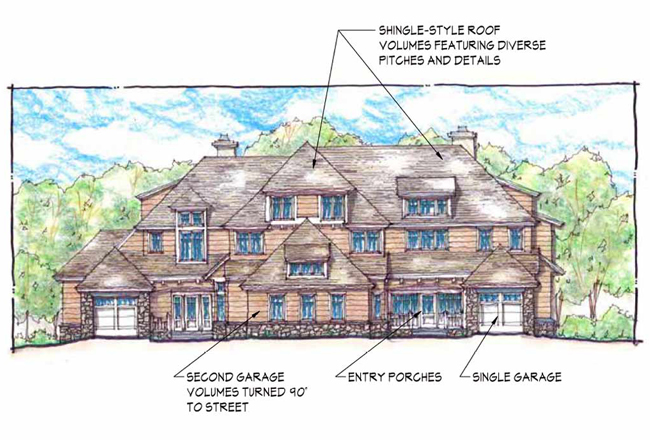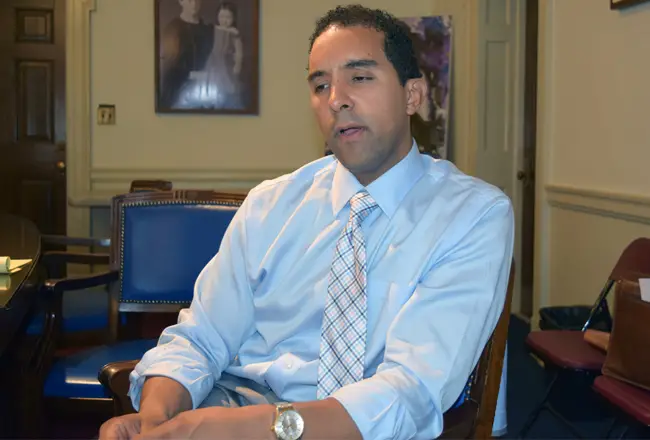
The nearly four-year-long environmental review process for a residential community proposed for the Hampshire Country Club in Mamaroneck soon may be coming to an end. Hampshire Recreation LLC, owner of the golf course and club, faced three rounds of questions and requests for additional information from the village of Mamaroneck”™s Planning Board after submitting its proposed Final Environmental Impact Statement (FEIS) in October 2018. Questions continued to be raised at the board”™s June 12, 2019, meeting.
The proposal is for 105 residential units, 64 of them carriage homes. Development would take place on 29 acres of the 116-acre property at 1025 Cove Road, off Orienta Avenue. What”™s now an 18-hole golf course would be reduced to nine holes. The clubhouse, tennis courts and other recreational facilities would remain. The golf course borders Delancey Cove on Long Island Sound.
Environmental reviews are conducted in accordance with New York”™s State Environmental Quality Review Act, known as SEQRA and sometimes just SEQR. The current environmental review process began in November 2015 when a scope of what needed to be done was adopted by Mamaroneck”™s Planning Board. The developer and its consultants did research and studies and submitted its proposed FEIS last October. Board members felt there were deficiencies and kept asking for additional information and studies. Much of the questioning concerned potential flooding during storms and whether a development at the country club could cause new or worsened flooding of other properties in the area.
An April 16, 2019, letter from David J. Cooper of the White Plains law firm Zarin & Steinmetz, which is representing Hampshire, told the Planning Board that his client had undertaken to evaluate every single comment that had been raised.
“Respectfully, it would be contrary to the intent of the SEQRA process to continue to disregard the technical information summarized above already provided by the Applicant and endorsed by your Board”™s own consultants,” he wrote.
The letter referenced board member Louis Mendes, repeatedly questioning the validity of data in the FEIS regarding flooding. Cooper pointed out that the data had been confirmed by Mamaroneck”™s consultant. It showed potential flooding from Long Island Sound waters during a major storm was not a significant issue. A subsequent letter from the law firm explained that the comments were not intended as personal criticism.
“Everything that was asked of Hampshire in the scope has been in the EIS for a long time,” Cooper told the Business Journal. He said they were concerned that the SEQRA process had become a sword to inhibit development rather than a shield to evaluate environment impacts. “Every municipality has their share of controversial matters, but ones that will drag out indefinitely, no. That”™s just not the way SEQRA was envisioned and is supposed to work,” Cooper said.
After some heated moments concerning the Hampshire”™s proposed FEIS at the June 12 Planning Board meeting, acting chairman Richard Litman said, “I”™d like to avoid any future examples of people yelling at each other ”˜cause it”™s not helping resolve the issues.” Litman asked that representatives of Hampshire and the village get together before the board”™s July 10 meeting and “work out any outstanding questions that we can then put into the final version and move this thing along. We”™re not looking to drag it out but my goal would be, you know, before the leaves fall off the trees we”™ll have this thing wrapped up, but who knows, we”™ll do our best.”
Cooper told the Business Journal that in many cases it takes only 30 days from the time a FEIS is submitted to the time it is accepted as complete and environmental findings are issued by the municipal body which is the lead agency for environmental review. “I do not believe the board needs four more months ”˜til the leaves fall to complete this process,” Cooper said. “The process started ”” the completeness process of the FEIS ”” started in October of 2018. And the SEQRA regulations do not allow, let alone envision, a completeness process that takes a year ”” over a year ”” to complete.”
At the June 12 meeting, Planning Board member Cindy Goldstein expressed skepticism that residents on the Hampshire Country Club”™s property could be safely evacuated if there ever was a bad storm surge affecting the Long Island Sound or another severe flooding condition.
Referring to the 300 or 400 people who would be living there, she said, “We all know how well people follow instructions and evacuate when they”™re told to. We”™ve got front-end loaders, which is how we evacuate people from peninsulas in this village. If you”™ve ever seen Flagler Drive evacuated, it”™s a lot of fun. It”™s very exciting, especially for senior citizens,” she said. “It”™s gonna be like the Florida Keys. The causeway is gonna be full.”
Civil engineer Michael Junghans of the firm Kimley-Horn, one of Hampshire”™s consultants, has said that a storm evacuation route would be created as a precaution, which could be used by all neighborhood homeowners and emergency vehicles as well as residents of the Hampshire development.
Attorney Michael Zarin addressed the board. “I think it”™s not a reasonable or relevant inquiry to speculate what could happen ”¦ and, yes, it could be difficult or there could be issues in the future, but as of now the laws do permit people to develop on those hundreds and hundreds of miles that unquestionably are going to be affected by climate change.”
Goldstein responded, “What I”™m suggesting is that the development be responsible and be appropriately respectful of human life, human property and the first responders, which we still do not have any kind of report from in terms of what the professionals evaluate this project to be.”
Zarin said, “It could be difficult but we”™ve demonstrated again using real data, tangible technical data, that you will be able to egress and ingress these sites. It will not be under water and that they”™re developable from a SEQRA and land-use, site-plan perspective.” He told the board, “If you believe that we have not satisfied your standards and you believe that somehow we haven”™t met our burden with respect to site-plan review and SEQRA findings, then you will write your SEQRA findings accordingly and you will vote on your resolution accordingly and you will lay out your rationale.”
Mendes spoke up. “I”™m sorry. You come here and you sit there and you talk to us as if, ”˜take it or leave it.”™ As you come here and you tell us that the proposal and report that you gave, you, is good enough for me to put 400 people there, so take it or leave it. OK, you totally come here, disrespect this whole body, this village, the people who live here. You understand that?”
Zarin started to speak but Mendes continued: ”Let me finish now, sir. Do you live in flood, in flooding, in flood areas in the city like the Rockaways, Broad Channel, Hamilton Beach? I know all of them. If you can work there, if you can, you see people live there. The problem is every day they wake up and their houses are flooded, but they like it because they live by the water. I can understand this. I can understand that the love of living by the water makes people do certain things that they shouldn”™t. It happens all the time.”
Then, Mendes got back to Mamaroneck. “We are not trying to fit 400 people into a development that we know is going to have problems and basically what you”™re saying is, ”˜yes, so what,”™ as long as we meet SEQRA and we can shove 400 people there and can sell these apartments for $10 million apiece, that”™s all I”™m looking for.”
Zarin said that he respects Mendes”™ opinion and respects the process and that Mendes”™ job is to ensure Hampshire has designed “the best project we can using the most advanced technology, best practice, in compliance with the law.”
Cooper told the Business Journal, “We are hopeful, cautiously optimistic, that this is the last round. We believe the board already has all of the facts that it needs to render a decision.”


















